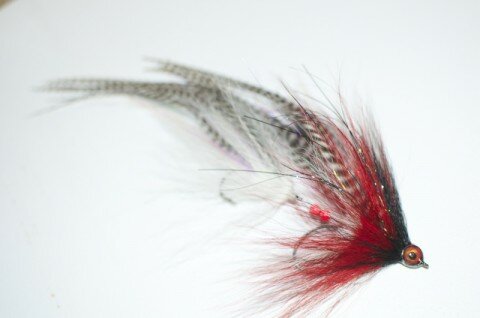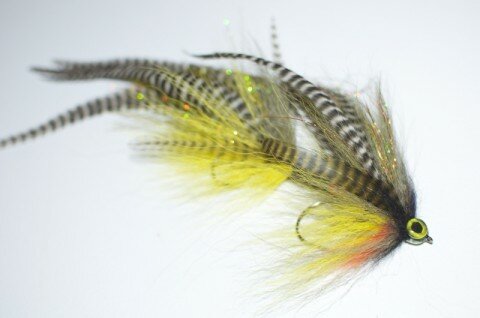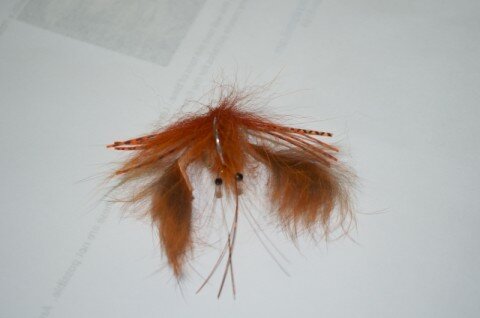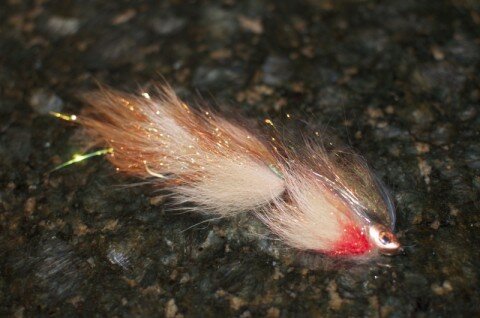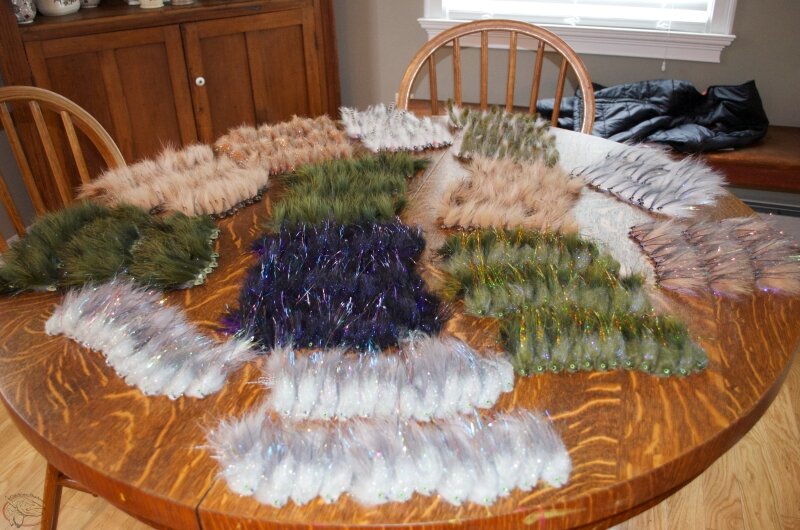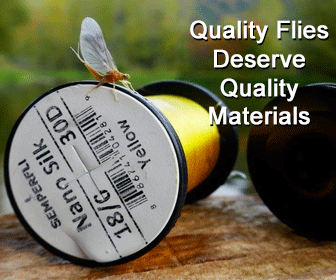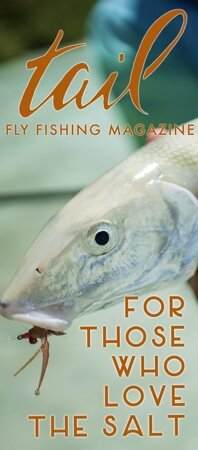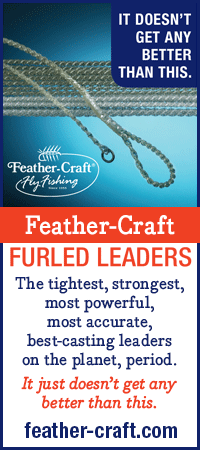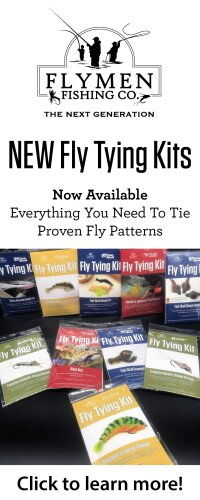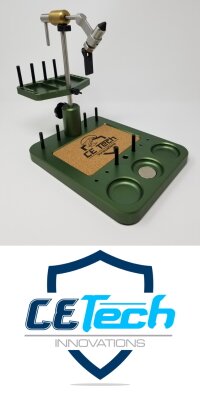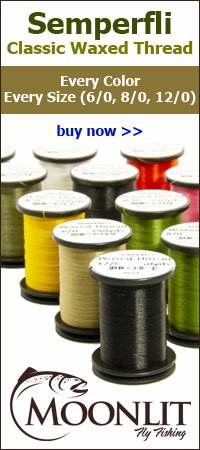Vertical Jig Style streamer pattern. Can be fished for several species. Jig style streamers are very overlooked patterns and styles, and this one is a deadly one.
Category Archives: Rich Strolis
Cellar Dweller – Rich Strolis
Comments Off on Cellar Dweller – Rich Strolis
Filed under Rich Strolis, Streamers
Rich’s Winter Stone – Richard Strolis
A small beaded nymph for the winter stoneflies that hatch in February through March on most Eastern Streams. Tie this fly in shades of black or brown in sizes 14-20 and you can cover your bases. Good luck and happy tying. Visit Rich’s blog Catching Shadows.
Filed under nymphs, Rich Strolis, Step by Step
New flies by Rich Strolis
Rich is on his way to ending the year with a bang! Rich explains some of his new offerings.
These flies are just a spin off of Brad Bohen’s Hangtime minnow, articulated of course. They come in at roughly a foot long and utilize reverse tied buck tail, a technique popularized by the Bob Popovics. Very durable, and swim like you’ve never seen. Colors are endless as you can tell. I’ve gotten the pike bug lately, and I have been playing with some 1/2 and 1/2 patterns using icelandic sheep in the rear of the flies as it swims and breaths like crazy (more on those in the weeks to come).
Expect to see some similar patterns that will fit into the trout category utilizing these materials and techniques shortly. I also have a new spin off of the crayfish, called the head case crab mostly due in part to a long conversation with Tim Flagler at Tightline Productions. And lastly, the Juggernaut is officially released as well. All of these are available in the newly updated fly store
http://catching-shadows.goodsie.com/
If anyone has some customizations in regards to colors or what have you, there is a new contact section on the store where they can do so.
http://catching-shadows.goodsie.com/contact
Filed under Rich Strolis, Streamers
Headcase Crayfish – Rich Strolis
This is one of Rich’s latest patterns. He worked hard on this pattern and put it through its paces. I’ve seen many posts on his Facebook page mentioning that he was working with this fly. In this video he shows how to tie his new crayfish style pattern and the information Rich posted with the video follows. I think it’s a very attractive pattern. Enjoy!
Here is my latest articulated streamer that I concocted to represent an adult crayfish. The fly comes in at around 3-3-1/2 inches and is what I would call a moderately weighted pattern that can be fished in a multitude of ways and with a floating or sinking line. So far she has racked up several species including northern pike, brown and rainbow trout, small and large mouth bass and even striped bass in the salt. Seconds for a great juvenile lobster pattern. Currently I tie it in the crayfish orange, olive/blue and tan colors but feel free to experiment.
Comments Off on Headcase Crayfish – Rich Strolis
Filed under Rich Strolis, Step by Step
Rich Strolis interview!
I notice you mention how much you love throwing big streamers these days. When did you realize that’s what you really enjoyed when fishing?
*My first fly caught fish when I was a young little rambunctious energy filled hooligan fell to a Muddler Minnow. I guess you could say that I have always had an affinity for streamers. I can honestly say that as an angler I have really come full circle at this stage of my life. I ran the nymph scene for several years and became very adept at fishing nymphs in all manners, as well as targeting all sorts of surface oriented feeding fish as well. I would have to say the last 10 or so years I have really gotten the bug for big stuff. Exclusively more so in the last couple years. Where I used to resort to streamers after fishing everything else or only during high water, now I fish them from the get go no matter what the conditions.
After big streamers, what would be your second fly type choice?
Smaller streamers. Come on Paul, that’s an easy one now. Well, in all seriousness if I had to pick a different style it would be tough to pick as I put nymphs and dry flies about even. So I guess it would come down to what the water told me. If a good fish was working the surface, I’d throw a dry. If the water showed no signs of this, then it would be a nymph of sorts.
How did you know you were ready to start selling your own flies?
It just sort of happened. When I was guiding often, I prided my trips on using my own recipes and concoctions when we were out there on the water. On my home waters of the Farmington River, the trout see everything, to say they are educated at times is an understatement. I always felt having something that the fish didn’t see day in and day out gave me an edge. My customers agreed by the end of our trip and some started asking if they were for sale. I started small and then it just blew up literally overnight. When you have a full time career on top of the custom fly/guide business, it can be problematic to juggle the two at times. There have been some times when I’ve had to shut things down for a bit as it has gotten overwhelming, you might be seeing that again really soon I’m afraid, I might have some changes in my career that are going to require a great deal of my time, so something will have to give.
When and how did you begin fly tying?
I began when I was about 11-12 after asking for a fly tying kit for Christmas. My gracious Aunt Diane bought one for me and the rest is history. I remember teaching myself how to tie by Dick Stewarts beginning fly tying book. It’s kind of amazing when I look back at how I began tying.
Did you have a fly tying mentor of any kind?
I would have to say even though he probably doesn’t know it, the fly tyer who influenced me the most was a local shop owner and commercial tyer named David Goulet. Dave, would offer up little bits and pieces of things on occasion while talking in his shop that always stuck with me. In the realm of fly design he in my opinion is one of the most under-rated designers of our time. Many of the patterns we fish today in our area originate with Dave, and he is what I would call an unsung hero of the fly tying world. I learned a great deal about the “Why” for materials, behavior, limitations, etc., that I owe entirely to Dave.
How many of your own patterns do you have now?
You know I couldn’t tell you off the top of my head, but probably dozens. Heck I have a few kicking around in my melon that still haven’t been put to iron yet.
Do you have any advice for fly tyers out there wanting to improve their skills?
Practice, practice, practice. Take a single fly and tie a dozen of them in a row. When they all start coming out the same, it’s time to move on to the next. Consistency is key in tying, plus, once you tie the same pattern a bunch of times in succession, chances are pretty good you’ll have the recipe memorized. Also, when buying materials, take the time to inspect what your purchasing. This holds true with natural materials more so than synthetics as every natural piece, hair, fur, feather is different.
Do you have a thought process when designing big streamers?
I either go with the concept of how do I want the fly to react in the water or in other words it’s action. Or, I am trying to emulate some sort of food form to a degree. The most important concept, and often most difficult one for newer tyers who like to tinker with ideas is the ability to think in reverse. When you are designing a pattern it is very much like building a house. You need a good foundation or otherwise the structure will fail. The same holds true with fly design, if you are trying to make a large profiled streamer with fewer materials, you better have a good foundation in place to achieve your idea. I see an influx of patterns posted daily all over the net that you can tell had very little thought behind them and are just experiments at the vise. Some of them look nice, but at the end of the day they may collapse, turn into a giant noodle or may have little or no movement to them when wet. Great flies not only look good, they perform and cover all of those facets. It is something that prospective fly designer needs to take into consideration. I also believe that some of the best fly designers are also fantastic fisherman too, the two are symbiotic influence the other.
How do you decide which materials to use when designing your streamers?
The materials that I choose for the streamers that I tie are typically based off of a three tiered system. Shape, size and action. Every material has a limitation in all of these areas, some materials rate high in all three categories and provide fewer limitations. Others need to be combined with other materials to get the balance that I may be after. What I always try to incorporate in my patterns is inherent motion, I like flies that move on their own without being manipulated as they give off the impression of being alive. What you will see in many of the flies that I come up with, many of the same types of material may be used in different ways as a direct result of this “lifelike” attribute.
Can you tell us anything about any new flies you are working on?
I have about a half dozen ideas floating around right now, but unfortunately I have had no time to set aside to play with them. My goal these days is to come up with one really good pattern a year. If I hit that target good things usually follow. I’ve got a couple of dead drift streamer ideas kicking around if that gives you any idea of where my head is these days.
When you have 10 or more of the same fly to tie, do you have any suggestions on being more effecient when tying this many?
Staging, it is a key ingredient to successful and efficient large quantity tying. This is especially the case with multi-piece flies like the articulated streamers that I tie. For instance, I may tie all the tail portions for a group of articulated flies first. But to stage things even more, I may pull all the materials first as well, marabou for the tail, flash, body material, wings, hooks etc., even cut the wire for the connection. After I tie the rear section I affix the wire and beads and set them aside. It is a much smoother process than doing the whole fly at once. After I do all the tail sections I connect them and finish them off. You can do the same thing with any pattern, but to a lesser degree. Take a weighted nymph for example, the staging process would merely be beading all the hooks and adding weight then setting them aside for completion. After I have done this for the entire allotment, I begin the tying process. A few years back when I had more free time (something I just can’t seem to remember these days), I would take an entire 100 pack of hooks and pre-bead and weight them, then all I would have left to do is tie the pattern later.
What can you tell us about your new big meaty streamer, the Juggernaut?
It’s more than a handful, and probably the top end size for trout to be honest. This guy has been leaked a little bit just stir up some interest a little bit. The fly itself comes in right at 8 inches long and is a culmination of a few of my patterns in one. The ice pick and hog snare had major influence on this particular pattern, and it is very evident when yuou see it. I was looking to have a pattern in the same size of the Double Deceiver that was also reminiscent of a larger baitfish. You all probably realize I really got a thing for fox fur, so it was paramount that the ingredient made its way into the flies construction. In the end I came up with a three sectioned fly that has a nice tapered design with a bunch of movement without sacrificing bulk. This fly should be a homerun, and already have a two part smaller version tied and in the works, probably call that one the “Juggy Junior”, for those who get the shakes by the size of the Juggernaut. Both flies have lots of promise and will most likely be in the store soon, the big guy however will probably have the highest price point I offer to date, so buyer beware.
Are trout always the target when you are designing flies?
For the most part yes, but I have found that several of my streamer patterns have crossed over into the warmwater and saltwater scenes rather nicely. I am a big trout chaser by heart, and living practically within a few minutes drive of a great trout fishery with several other good rivers within a 3 hour radius, it is safe to say I am a trout fisherman to the core. I do spend some time on the flats of Cape Cod, but my time there is limited. I have a bunch of other pattern ideas for the salt and for the warmwater scene, pike and smallmouth especially as I have some pretty good fishing for both species rather close as well. You may find me chasing Snot Rockets when the streamer bite for trout is off this year, it seems my affinity for streamers has gripped me pretty bad and I am having a tough time wavering these days. I have nightmares of big browns chomping chicken sized flies, but who knows, my friend Pat Cohen has really talked up Carp fishing to me, and I think I may have a new sickness after this year so stay tuned.
What size of thread do you use on your streamers?
I am a huge fan of the UTC 140 thread and I use it pretty much 99% of the time. It has good stretch and strength and it lays out nice and flat. On occasion I will use some 210 for some of the bigger flies I tie, as I try to use the largest thread possible without compromising the pattern. The new Veevus threads are really awesome and I find myself turning to them more for my bugs these days, but sticking with the UTC for the streamers.
In your opinion, what is the definition of a good fly tyer?
Boy this is a great question, a good tyer to me is one that can tie a pattern in succession with all of them looking virtually identical, while also being versatile in the pattern department. What I mean with versatile is basically being able to tie a wide variety of patterns in all different styles; a 26 midge, winged wet, bucktail streamer to a complex multi-sectioned streamer. What makes a GREAT fly tyer in my book is a tyer that can do all of that quickly, efficiently and has a great creative sense to build upon old patterns or make new fresh patterns while also having a great understanding of how the materials behave and are utilized properly. That same tyer should have a strong ability to convey that at the vise to others. That was one of the biggest reasons I got into doing tying videos. I have seen some of the best tyers in the world, some are phenomenal tyers and unbelievably fast, but are not the best at explaining or instructing others on the steps taken in the construction of a solid fly.
What hooks do you like to use?
I use a wide variety of hooks these days, I am a huge fan of Gamakatsu Hooks for all of my streamers but this may be changing soon. You just might be seeing me substituting some Partridge hooks soon, as they have some really awesome hooks as well. Gamakatsu has some really sticky sharp hooks, the percentage of error per thousand of hooks is ridiculously low from my experience as I have found less than 6 bad hooks in tens of thousands of hooks that I have tied on. For bugs I use a bunch of different brands; TMC, Dohiku, Partridge, Daiichi are a few. My thought process for hooks goes hand in hand with my fly design, the hook is my canvas much like a painter. A certain style or shape of hook is used to accomplish what I am trying to build into a fly. For the most part, there are a slew of great hooks out there, find what you like and roll with it.
Do you have any plans of designing another nymph or even a dry fly in the future?
Absolutely, like I said earlier it will just come down to setting some time aside to do so. I still enjoy targeting rising fish, and nymphing a good riffle even though I do both a little less these days. There are some ideas rolling around in my melon these days, more along some hatches that I haven’t had a lot of time targeting. Big stuff, Drakes, Hexes, etc….
What is your favorite classic fly?
Toss up between a Muddler Minnow or a Grey Ghost.
I know recently you battled with adding the color black to your Headbanger Sculpins, because there wasn’t a fish skull to match. What are your thoughts on color choices when you are designing your flies?
In the streamer realm, I think color is one of if not the most important ingredient to one’s success. A lot of the time on the water when throwing meat so to speak, it isn’t always the pattern, it is more often the color that the fish key in on. There are always exceptions to both but having a variety of colors in your arsenal is very beneficial from my experiences. If you look at a lot of the streamers I tie and fish, they are multicolored for a variety of reasons. Just about all of the food forms that we are trying to replicate with streamers are multicolored to begin with. A fly with multiple colors will look a little more lifelike in the water column than a pattern that is one solid color. Now, solid colored flies do produce well from time to time, but multicolored flies seem to really fit the bill a bit better. Have a mix of both, and take a couple of your confidence patterns and expand your selection by having those flies in a few different color combinations.
Is there anything at all you would like to add?
Thanks for the interview, but like everything I have going on these days, I gotta get back to the vise to complete a rather large order for Tim Bull down at the ToadFly in Arkansas. The sooner I get these guys done the sooner I get out on the water to chase Toads. Later Paul…..
Thank you for taking the time to do an interview with FrankenFly Rich!
Don’t forget to follow Rich’s blog, Catching Shadows.
Filed under Interview, Rich Strolis
Prelude to Strolis interview…
I’m in the process of putting the final touches on a Rich Strolis interview. It should be up tomorrow sometime. In the meantime, I thought this would be a good chance to post an updated video from Rich on his Ice Pick streamer. Check it out and be sure to come back for the interview, it’s gonna be a good one!
Comments Off on Prelude to Strolis interview…
Filed under Rich Strolis, Streamers
Realistic Baitfish video – Rich Strolis
Rich released a new video today on his new baitfish pattern, Realistic Baitfish. Rich now has this pattern available in his store for custom order. This looks like an effective pattern and an easy tie. Rich does a great job as usual with the tying video provided below.
Filed under Rich Strolis
New video from Brian Wise – Rich Strolis Bloodied Baitfish
I had posted several weeks back about Brian and Rich being on the same page. But now, I’m really thinking they have a mind-link to one another. What is on their collective mind you ask? Bloodied Baitfish, that’s what!
Brian Wise has released his newest fly tying video! This is the second pattern he has chosen from Rich Strolis’s list of fly pattern creations. I’m a fan of Rich’s Bloodied Baitfish, so it was good to see Brian choose this one.
Rich just posted today that he made some changes and added some things to his Bloodied Baitfish video. You can find it below.
Comments Off on New video from Brian Wise – Rich Strolis Bloodied Baitfish
Filed under Brian Wise, Rich Strolis

